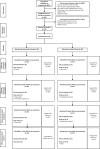Foot-ankle therapeutic exercise program can improve gait speed in people with diabetic neuropathy: a randomized controlled trial
- PMID: 35534614
- PMCID: PMC9082985
- DOI: 10.1038/s41598-022-11745-0
Foot-ankle therapeutic exercise program can improve gait speed in people with diabetic neuropathy: a randomized controlled trial
Erratum in
-
Author Correction: Foot-ankle therapeutic exercise program can improve gait speed in people with diabetic neuropathy: a randomized controlled trial.Sci Rep. 2022 Jul 11;12(1):11768. doi: 10.1038/s41598-022-16172-9. Sci Rep. 2022. PMID: 35817813 Free PMC article. No abstract available.
Abstract
This study sought to determine whether a foot-ankle therapeutic exercise program can improve daily physical activity (i.e. number of steps) and fast and self-selected gait speed in people with diabetic peripheral neuropathy (DPN). In this single-blind randomized controlled trial and intention-to-treat analysis, 78 volunteers with DPN were allocated into a control group, which received usual care, and an intervention group (IG), which received usual care plus a 12-week foot-ankle exercise program. The adherence at 12 weeks rate in the IG was 92.3% (36 participants) and the dropout was 5.1% in the control group (2 participants). The number of steps and self-selected gait speed did not change significantly in either group (p > 0.05), although a 1,365-step difference between groups were observed at 1-year followup. The 12-week foot-ankle therapeutic exercises improved significantly fast-gait speed (primary outcome) (p = 0.020), ankle range of motion (p = 0.048), and vibration perception (secondary outcomes) (p = 0.030), compared with usual-care at 12 weeks. At 24 weeks, the IG showed better quality of life than controls (p = 0.048). At 1-year, fast-gait speed and vibration perception remained higher in the IG versus controls. Overall, the program may be a complementary treatment strategy for improving musculoskeletal and functional deficits related to DPN.Trial registration ClinicalTrials.gov NCT02790931 (06/06/2016).
© 2022. The Author(s).
Conflict of interest statement
The authors declare no competing interests.
Figures
References
-
- van Sloten TT, Savelberg HHCM, Duimel-Peeters IGP, Meijer K, Henry RMA, Stehouwer CDA, et al. Peripheral neuropathy, decreased muscle strength and obesity are strongly associated with walking in persons with type 2 diabetes without manifest mobility limitations. Diabetes Res. Clin. Pract. 2011;91:32–39. doi: 10.1016/j.diabres.2010.09.030. - DOI - PubMed
Publication types
MeSH terms
Associated data
LinkOut - more resources
Full Text Sources
Medical



